The missteps of the 2021 offseason for the Boston Red Sox has the 2022 possibilities under a tight microscope.
Make the right moves, and it could set this franchise on a successful path for years to come. Wrong moves — or lack thereof — and the Red Sox future might be a middling one.
Twenty-five years ago, the Red Sox were in a similar position to decide their fates. Coming off a losing season in 1997, the Red Sox were looking for answers to rise past their mediocrity. The franchise had four losing seasons to that point in the decade, with four winning seasons and never reaching more than 88 wins.
The 1997 offseason, and midseason, turned out to have franchise altering moves that laid the path to Boston winning to four World Series titles in 14 years.
Boston Red Sox: 1997 & 2022 seasons
A big swing is desired this offseason for the Red Sox after a 78-84 record in 2022.
Similarities between the two seasons can be found in both the pitching and hitting departments. Much like in ’22, 1997 saw only two pitchers reach double digits in victories. This last season, Michael Wacha (11-2) and Nick Pivetta (10-12) were the big winners, with Aaron Sele (13-12) and Tim Wakefield (12-15) snagging the honors in ’97.
Sele’s 13 wins and 5.38 ERA were traded following the season, where he was packaged in a deal that brought Jim Leyritz and Damon Buford to Boston. Buford lasted only two seasons with the Red Sox, though one of his better seasons in the majors was in 1998 with Boston.
Leyritz was gone in a flash, lasting only until June of ’98, when he was traded to the Padres.
Hitting, too, took on similar elements, though 1997 has the nod thanks to the slugging of Mo Vaughn and Nomar Garciaparra. Both hit for power with 35 and 30 home runs, respectively. Something definitely missing in 2022, where Rafael Devers led the team with 27 and the only play to cross the 20-home run mark.
The lineup was the lesser of Boston’s concerns following the ’97 season. Both Vaughn and Garciaparra helped lift the Red Sox to a 92-70 record in 1998, starting a streak of 14-straight winning seasons. Vaughn hit .337 that season with 40 home runs and Garciaparra hit 35, with 122 RBI and a .323 batting average.
Both were gone by time the Red Sox won that World Series title in 2004 but were very important in the development of a winning culture. The real impact arrived in the form of pitching during 1997 offseason.
